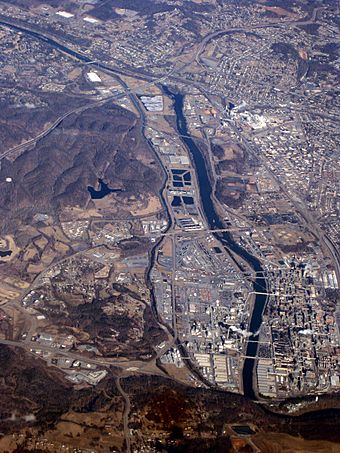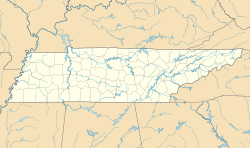Long Island (Tennessee) facts for kids
|
Long Island of the Holston
|
|

Aerial view of the island
|
|
| Location | S. Branch Holston River, Kingsport, Tennessee |
|---|---|
| Area | 840 acres (340 ha) |
| Built | 1760 |
| NRHP reference No. | 66000733 |
Quick facts for kids Significant dates |
|
| Added to NRHP | October 15, 1966 |
| Designated NHLD | October 9, 1960 |
Long Island (Cherokee: ᎠᎼᏰᎵ ᎫᎾᎯᏔ, romanized: Amoyeli Gunahita), also known as Long Island of the Holston, is an island in the Holston River. It is located near Kingsport in East Tennessee. This island has been very important throughout history, even before European settlers arrived. It is listed on the National Register of Historic Places. It is also a U.S. National Historic Landmark District. This means it is a place with special historical importance.
Contents
Geography of Long Island
Long Island is found across the main part of the South Branch Holston River. It is right next to downtown Kingsport. The island is about 4 miles (6.4 km) long. At its widest point, it is about 0.5 miles (0.8 km) across.
A smaller river channel, called the Sluice, runs along the island's southern side. Bridges carry Tennessee State Route 126 over both river channels. This road crosses the island about two-thirds of the way down. Another bridge connects Jared Drive to the mainland near the island's southern tip. A large part of the area south of SR 126 is used by Eastman Chemical Company.
A Look at Long Island's History
Long Island of the Holston River was a very important place for the Cherokee people. It was also important for their ancestors, who lived there for thousands of years. This island was part of their homelands. Their lands stretched into what is now North Carolina, South Carolina, and Georgia. It was a sacred place for meetings and signing treaties among the Cherokee.
Early Settlers and the Wilderness Road
European pioneers and early settlers also used the island. They liked its good location. The Timberlake Expedition in 1761–62 started and ended here. Daniel Boone began his journey from Long Island in 1775. He started clearing the Wilderness Road from here. This road went through the Cumberland Gap into Kentucky.
The Revolutionary War and Treaties
During the American Revolution, the Cherokee joined with the British. They hoped to remove colonists from their land. In July 1776, they fought against frontiersmen.
Later, European-American settlers built Fort Patrick Henry. It was on the north bank of the South Fork of the Holston River. Colonel William Christian led 2,000 men against the Cherokee towns. They stopped the Cherokee's resistance.
The 1777 Treaty of Long Island (also called the Avery Treaty) was signed here. This treaty said that the Cherokee still owned Long Island. However, they gave up their claims to other land in East Tennessee that white settlers had taken. That year, Colonel John Martin became the US Indian Agent. He set up a trading post on Long Island. He lived there for ten years with his Cherokee wife, Betsy War.
Island Development and Trade
The island became a starting point for settlers moving west by river. They traveled to places like middle Tennessee. People would arrive here by land. Then, they would build flatboats or barges to continue west by water. They would go down the Tennessee River. Building these boats helped the community of Christianville grow. It was on the north bank of the Holston, at the west end of Long Island.
On January 7, 1806, Henry Dearborn bought the island from the Cherokee people. He was the United States Secretary of War for President Thomas Jefferson. This was part of an effort to set the western border of the country.
In 1810, the family of Samuel Woods managed to get the land from the US government. Richard Netherland, who married one of Woods's descendants, bought the land from the family. He started a large farm and businesses on the island.
In 1822, the settlements of Christianville and Rossville joined together. They were named the Town of Kingsport. It became an important shipping port on the Holston River. Goods from the nearby countryside were loaded onto boats. These boats then traveled downstream to the Tennessee River. From there, goods were sent to other markets. The town lost its official status after the American Civil War caused problems.
Long Island in the 20th Century
During the Prohibition Era, when alcohol was illegal, the island became a place where people tried to smuggle illegal alcohol. This sometimes led to problems.
In 1960, Long Island of the Holston was named a National Historic Landmark District. This was because of its important role in both Native American and United States history.
Later in the 20th century, much of Long Island was developed for large factories. Eastman Chemical Company built many facilities there. This greatly changed how the island looked. Few old homes or historic buildings remain. Most of the trees and plants were removed from this area. In 1996, some people thought the island should lose its Landmark status. This was because so much of its historic look had changed. However, it still has the National Historic Landmark designation.
On July 16, 1976, the city of Kingsport gave back 3.61 acres of the island. This land was described as "Sacred Cherokee ground." It was returned to the Eastern Band of Cherokee Indians (EBCI). This is a Native American tribe based in Western North Carolina. Other Cherokee tribes are in Oklahoma. Their ancestors were moved there by US military forces in the 1830s.
This returned land is now part of a city park on the west end of the island. The park also has sports fields and other fun areas. The EBCI is the only federally recognized tribe in North Carolina. Since the late 1900s, they have worked to get back sacred sites and former lands of the Cherokee in this region. They have bought several sites in western North Carolina. These sites have sacred mounds that are believed to be over 1000 years old.
Population on the Island
Most of Long Island is inside the city limits of Kingsport. The number of people living on Long Island was highest between 1955 and 1963. At that time, there were 517 homes and about 1,800 people. As of 2019, only a few houses are left on the island.
Images for kids
See also
 In Spanish: Isla Larga (Tennessee) para niños
In Spanish: Isla Larga (Tennessee) para niños




